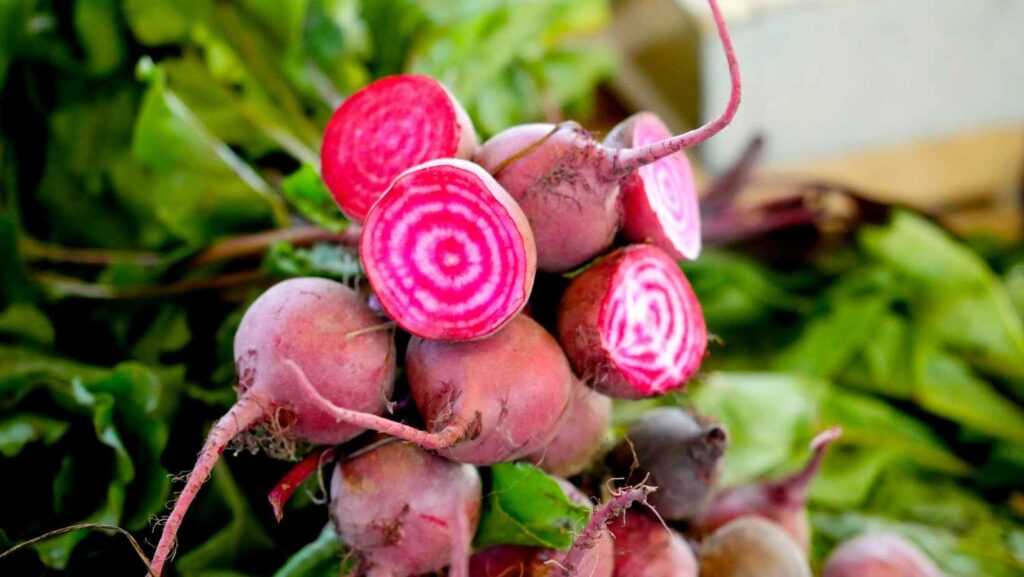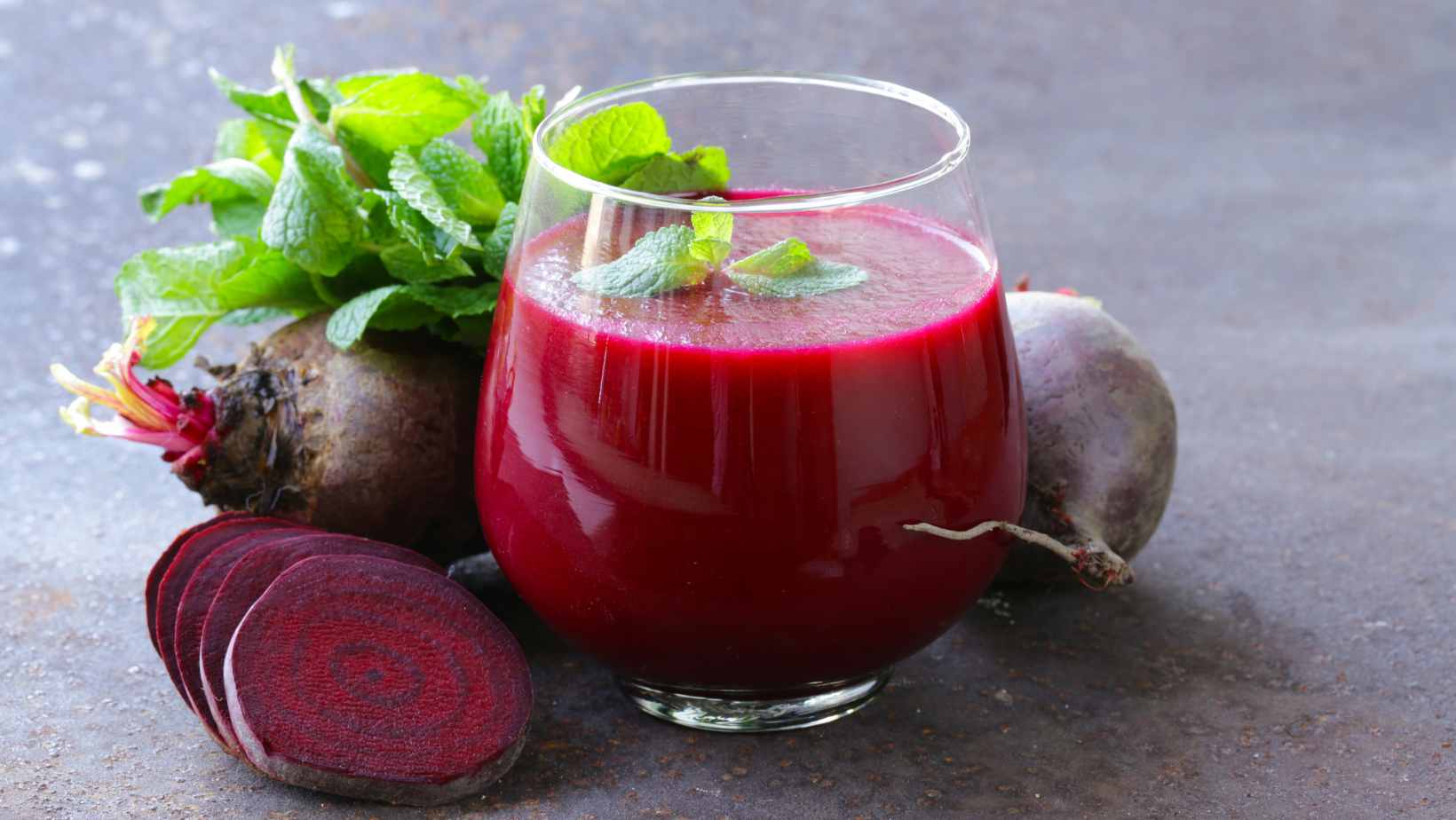To avoid the adverse effects of beets on your digestion, high FODMAP content, the chances of developing kidney stones, and how beets may interact with your medications, explore this section discussing the drawbacks of eating beets. By understanding the potential drawbacks, you’ll know how to consume beets safely and avoid experiencing these negative effects.
Possible Adverse Effects on Digestion
Consuming beets may potentially cause digestive problems. The high fiber content of beets can lead to bloating, abdominal discomfort, and gas. These symptoms are especially prevalent in individuals with digestive disorders such as irritable bowel syndrome. Additionally, the presence of oxalates in beets can contribute to kidney stone formation in susceptible individuals.
It is important to note that cooking or fermenting beets can decrease their negative effects on digestion. Moreover, incorporating other sources of fiber and staying hydrated can also help alleviate any digestive issues caused by consuming beets.
Historically, beet consumption dates back to ancient civilizations such as the Romans and Greeks who consumed them for medicinal purposes. However, it wasn’t until the 19th century when beets were used for sugar production that they became a common dietary addition.
Beets may be high in FODMAPs, but who needs a functioning digestive system when you have a healthy dose of sarcasm?
Are beets low fodmap
Beet consumption leads to high FODMAP content, which may trigger digestive discomfort in some people. A low FODMAP diet could assist in managing these symptoms.
A table comparison of beets versus other vegetables shows that the former contains more fructose and sugar alcohols, which could exacerbate IBS symptoms. For instance, a single raw beetroot weighing 82g has 2.9g of fructans compared to a raw carrot of similar mass, which has only 0.24g.
Furthermore, consuming excessive quantities of beets may cause urine discoloration due to their naturally occurring pigments, anthocyanins.
It is a known fact that beets contain an incredibly potent antioxidant called betalain, according to Medical News Today.
Looks like we’ll have to beet around the bush when it comes to kidney stones caused by excess beet intake.
Excess Intake can Lead to Kidney Stones
Beet consumption in excess can result in the development of kidney stones. The presence of oxalates in beets leads to hyperoxaluria, which is a condition that results in increased oxalate production and excretion in urine. This increase in oxalate levels can lead to the formation of kidney stones.
Consuming beets regularly or relying heavily on them as a dietary supplement can have dire consequences. The high concentration of oxalates present in beets can bind with minerals like calcium and form crystals that accumulate and eventually create small lumps called kidney stones.
It’s vital to remember that certain factors like dehydration, genetics, age, obesity, and some medications and medical conditions also contribute to the development of kidney stones. However, limiting beet intake can help reduce the risk of forming these harmful stones.
Interestingly, ancient Romans used beet juice as an aphrodisiac while the Greeks believed it had potent health benefits like aiding disease recovery and vitality restoration.
Looks like you’ll have to choose between your love for beets and your medication regimen, unless you’re willing to risk turning your insides into a Jackson Pollock painting.
Beets may Interfere with Certain Medications
Beets have been known to impede the effectiveness of certain medications due to their high level of nitrates. Nitrates can be converted into nitrites by bacteria in saliva and eventually be transformed into nitric oxide. Nitric oxide, in turn, can cause a decrease in blood pressure, which may interfere with medications like sildenafil (Viagra) that are taken for erectile dysfunction. Additionally, chemotherapy drugs like cisplatin may also be impacted, as they rely on lower levels of nitric oxide for optimal efficacy.
Moreover, it is crucial to note that individuals who frequently consume beetroot juice or supplements must inform their healthcare providers about their usage. This practice ensures that medical professionals can adjust medication dosages appropriately or steer towards alternative treatment options if required. However, some studies suggest that this interaction between beets and medication may vary depending on different factors such as age and underlying health conditions.
In history, the impact of beet interaction with medication was first noted when a patient taking anti-hypertensive medication experienced acute hypotension after consuming beetroot juice. Following this incident, several other cases were reported involving medications like sildenafil and dobutamine. Therefore, those regularly consuming beet supplements or taking prescribed medicines should speak with their healthcare practitioners before doing so.
Going on a low FODMAP diet is like playing hide and seek with your digestive system, but the stakes are much, much higher.
The Low FODMAP Diet
To follow the low FODMAP diet with a focus on digestive wellness, you need to understand what it is and why it is crucial for people with digestive issues. Of course, it’s also important to know which high FODMAP foods to avoid as well as how to find alternatives to them. In this section of the article, we will briefly introduce the Low FODMAP Diet as a solution for digestive issues and discuss the sub-sections that will help you get started on following it.
What is the Low FODMAP Diet?
The Low FODMAP Diet is a dietary approach to manage gut-related disorders such as irritable bowel syndrome (IBS). It involves restricting the intake of FODMAPs – fermentable carbohydrates that can trigger digestive symptoms. Following this diet involves guidance from a registered dietitian and temporarily avoiding high-FODMAP foods, reintroducing them systematically and identifying personal triggers. This method has proved effective in reducing symptoms of IBS.
In addition to minimizing gastrointestinal distress, following a Low FODMAP Diet can also lead to significant improvements in daily life and social functioning. For instance, individuals with IBS who follow this diet report fewer instances of bloating, gas, and diarrhea.
Recent studies have pointed out that while the Low FODMAP Diet can be effective in treating specific health conditions, it is not meant to be followed strictly long-term. A 2019 study by Tuck et al. revealed that following a low-FODMAP diet for prolonged periods can result in potential negative effects on the gut microbiome’s diverse composition.
Sources:
- Tuck CJ, Taylor KM., Gibson PR., Barrett JS., Muir JG. (2019). Increasing Symptoms and Gut Dysbiosis Following Residential Relocation: A Pilot Study. Link
- Saying goodbye to beloved foods is hard, but with the Low FODMAP diet, you’ll finally have an excuse to avoid your in-laws’ casserole.
Why is it Important for People with Digestive Issues?
For individuals with digestive issues, following the Low FODMAP diet can produce significant benefits. This particular diet identifies and eliminates fermentable carbohydrates that may cause gas, bloating, and discomfort in the gut.
Moreover, the Low FODMAP diet has been proven to be effective in managing Irritable Bowel Syndrome (IBS), a common gastrointestinal disorder. Studies have shown that following this diet plan for at least 4-6 weeks leads to a significant reduction in symptoms such as abdominal pain, diarrhea or constipation.
It is important to note that the Low FODMAP diet should not be followed long-term as it is restrictive and can lead to nutrient deficiencies if not managed carefully. It is recommended to work with a registered dietitian when embarking on this eating plan.
Incorporating the Low FODMAP diet into your lifestyle can improve quality of life by reducing uncomfortable symptoms associated with digestive issues. Don’t miss out on feeling your best during daily activities – consult with a professional today.
Looks like my diet just got a FODMAPing makeover – turns out I can’t have my cake and FODMAPs too.
Which Foods Should Be Avoided on the Low FODMAP Diet?
The Low FODMAP Diet is a specialized diet recommended for individuals with irritable bowel syndrome or other gastrointestinal disorders. To maximize results, it’s crucial to know which types of food to avoid.
- High FODMAP fruits: apples, pears, watermelon
- High FODMAP vegetables: broccoli, onions, garlic
- High FODMAP grains: wheat, rye, barley
- Milk and dairy products containing lactose
In addition to the above, sweeteners like fructose and honey should also be avoided. It’s important to keep in mind that each person reacts differently to foods and that working with a registered dietitian can help determine an individualized list of foods to avoid.
As you begin your journey on the low FODMAP diet, it’s important to note that certain processed and packaged foods may also contain high FODMAP ingredients. Be sure to thoroughly check labels before purchasing to ensure they align with the dietary restrictions.
With so many delicious foods off-limits on the low FODMAP diet, it can be difficult to stay motivated. However, remember that by sticking closely to these guidelines, you can reduce symptoms like bloating and abdominal pain significantly!
Out with the old, in with the low – finding alternatives to high FODMAP foods has never been so bittersweet.
Finding Alternatives to High FODMAP Foods
Looking for substitute options for high FODMAP foods can be a daunting task when following the low FODMAP diet. However, it is essential to ensure one’s well-being and eliminate any potential discomforts caused by such foods. Here are some tips that may help you find appropriate alternatives that suit your needs:
- Opt for fresh fruits and vegetables instead of canned or frozen varieties.
- Use gluten-free alternatives instead of regular wheat-based products.
- Choose lactose-free dairy products over regular ones.
- Experiment with different herbs and spices to add flavoring without the risk of high FODMAP ingredients.
When exploring substitute options, keep in mind that some packaged products labeled as “gluten-free” or “dairy-free” may still contain high FODMAP ingredients. Thus it is imperative to read food labels and identify any potential trigger ingredients.
A noteworthy aspect to consider while replacing high FODMAP diet components is that substitution does not mean completely eliminating a food group from your diet. Thus it is advisable to engage with an experienced professional to avoid unnecessary dietary restrictions.
A recent study published on PubMed Central confirms that the low FODMAP diet helps relieve symptoms in patients with irritable bowel syndrome (IBS).
Beets on the Low FODMAP Diet? Sounds like a vegetable-based horror movie.
Beets on the Low FODMAP Diet
To manage your low FODMAP diet with beets, check out these sub-sections: Can Beets be Included in a Low FODMAP Diet?, The Importance of Portion Control, and Tips on Preparing Beets for a Low FODMAP Diet. These will provide solutions for the potential drawbacks of eating beets, helping you to incorporate this nutritious vegetable into your low FODMAP diet without any issues.
Can Beets be Included in a Low FODMAP Diet?
Beets are a low FODMAP vegetable with a slightly sweet, earthy flavor and numerous health benefits. The question of whether beets can be included in a low FODMAP diet is essential, and the answer is yes. With a proper serving size, one can safely consume beets while following the low FODMAP diet.
Beets contain fructans, which are a type of carbohydrate that some people might have difficulty digesting. However, beets are only high in fructans when consumed in large amounts. Therefore, it is safe to add them to your low FODMAP meal plan as long as you stick to the recommended serving size.
Apart from being a delicious addition to any meal, beets are also rich in essential nutrients like folate and betaine. These nutrients can help improve digestion, support healthy blood pressure levels, and protect against chronic diseases.
A friend of mine who has IBS began following the low FODMAP diet and was hesitant to include beets because of their supposed high fructan content. After doing some research together, we discovered that beets were safe for her to eat in moderation while following the diet. She now enjoys adding roasted beet chunks to her salads without any negative digestive effects.
Remember, there’s a fine line between portion control and pretending you’re on a hunger strike.
The Importance of Portion Control

Controlling the Quantity of Beets in Low FODMAP Diet
Consuming the correct amount of beets while following the low FODMAP diet is essential for reducing digestive discomfort. Proper portion control helps in avoiding excess fodmaps intake and reducing symptoms such as bloating, diarrhea, and constipation.
The recommended serving size of beets for FODMAP dieters is half a cup or around 75 grams. Consuming more than this amount can lead to an increase in the number of FODMAPs and trigger gastrointestinal issues. Measuring portions and keeping track of food consumption aid in controlling quantity.
Moreover, certain varieties of beets contain higher amounts of FODMAPs than others. It is essential to check labels on food packages or seek professional guidance while picking your vegetables at the grocery store.
Make sure not to miss out on controlling your beet intake and sticking to the recommended serving size. Eating excessive amounts can cause painful symptoms that may hinder your daily routine, indicating the importance of proper portion control while consuming these healthy veggies.
Why cry over onions when you can dance with beets on a Low FODMAP diet? Here are some tips to make the most of this funky root vegetable!
Tips on Preparing Beets for a Low FODMAP Diet
Preparing Beets for a Low FODMAP Diet
Beets are nutrient-dense vegetables that make a delicious addition to any diet, especially for those following the low FODMAP diet. Here are some tips on preparing beets for this particular dietary restriction:
- Use small to medium-sized beets
- Boil or roast the beets instead of grilling or sautéing them
- Remove the skin before eating
- Limit your serving sizes to 1 cup or less
- Add low FODMAP seasonings such as cinnamon, ginger, or dill
- Experiment with different cooking methods to find what works best for you
When preparing beets for a low FODMAP diet, it is essential to remember that just because they are healthy, doesn’t mean they will sit well with all individuals. Therefore, it is always recommended that you introduce them gradually into your meal plan and monitor how your body responds.
A friend was recently diagnosed with IBS and started incorporating more beets into their diet. They found that boiled beets add an earthy sweetness to salads and roasted beets make a delicious side dish paired with fresh herbs like thyme. They’ve successfully integrated this vegetable into their diet without experiencing any adverse symptoms related to their IBS.
Whether to beet or not to beet on a Low FODMAP Diet, that is the onion – I mean, the question.



